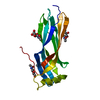+Search query
-Structure paper
| Title | TMEM106B is a receptor mediating ACE2-independent SARS-CoV-2 cell entry. |
|---|---|
| Journal, issue, pages | Cell, Vol. 186, Issue 16, Page 3427-3442.e22, Year 2023 |
| Publish date | Aug 3, 2023 |
 Authors Authors | Jim Baggen / Maarten Jacquemyn / Leentje Persoons / Els Vanstreels / Valerie E Pye / Antoni G Wrobel / Valeria Calvaresi / Stephen R Martin / Chloë Roustan / Nora B Cronin / Eamonn Reading / Hendrik Jan Thibaut / Thomas Vercruysse / Piet Maes / Frederik De Smet / Angie Yee / Toey Nivitchanyong / Marina Roell / Natalia Franco-Hernandez / Herve Rhinn / Alusha Andre Mamchak / Maxime Ah Young-Chapon / Eric Brown / Peter Cherepanov / Dirk Daelemans /    |
| PubMed Abstract | SARS-CoV-2 is associated with broad tissue tropism, a characteristic often determined by the availability of entry receptors on host cells. Here, we show that TMEM106B, a lysosomal transmembrane ...SARS-CoV-2 is associated with broad tissue tropism, a characteristic often determined by the availability of entry receptors on host cells. Here, we show that TMEM106B, a lysosomal transmembrane protein, can serve as an alternative receptor for SARS-CoV-2 entry into angiotensin-converting enzyme 2 (ACE2)-negative cells. Spike substitution E484D increased TMEM106B binding, thereby enhancing TMEM106B-mediated entry. TMEM106B-specific monoclonal antibodies blocked SARS-CoV-2 infection, demonstrating a role of TMEM106B in viral entry. Using X-ray crystallography, cryogenic electron microscopy (cryo-EM), and hydrogen-deuterium exchange mass spectrometry (HDX-MS), we show that the luminal domain (LD) of TMEM106B engages the receptor-binding motif of SARS-CoV-2 spike. Finally, we show that TMEM106B promotes spike-mediated syncytium formation, suggesting a role of TMEM106B in viral fusion. Together, our findings identify an ACE2-independent SARS-CoV-2 infection mechanism that involves cooperative interactions with the receptors heparan sulfate and TMEM106B. |
 External links External links |  Cell / Cell /  PubMed:37421949 / PubMed:37421949 /  PubMed Central PubMed Central |
| Methods | EM (single particle) / X-ray diffraction |
| Resolution | 2.59 - 4.83 Å |
| Structure data |  EMDB-17169: Cryo-EM structure of the SARS-CoV-2 Spike bound to TMEM106B  EMDB-17170: Local refinement of the SARS-CoV-2 Spike RBD bound to TMEM106B  PDB-8b7d: |
| Chemicals |  ChemComp-NAG:  ChemComp-HOH: |
| Source |
|
 Keywords Keywords |  MEMBRANE PROTEIN / luminal domain / fibronectin type III (Fn3) / 7-bladed beta-sandwich fold / MEMBRANE PROTEIN / luminal domain / fibronectin type III (Fn3) / 7-bladed beta-sandwich fold /  receptor binding / SARS CoV2 / receptor binding / SARS CoV2 /  Covid19 Covid19 |
 Movie
Movie Controller
Controller Structure viewers
Structure viewers About Yorodumi Papers
About Yorodumi Papers





